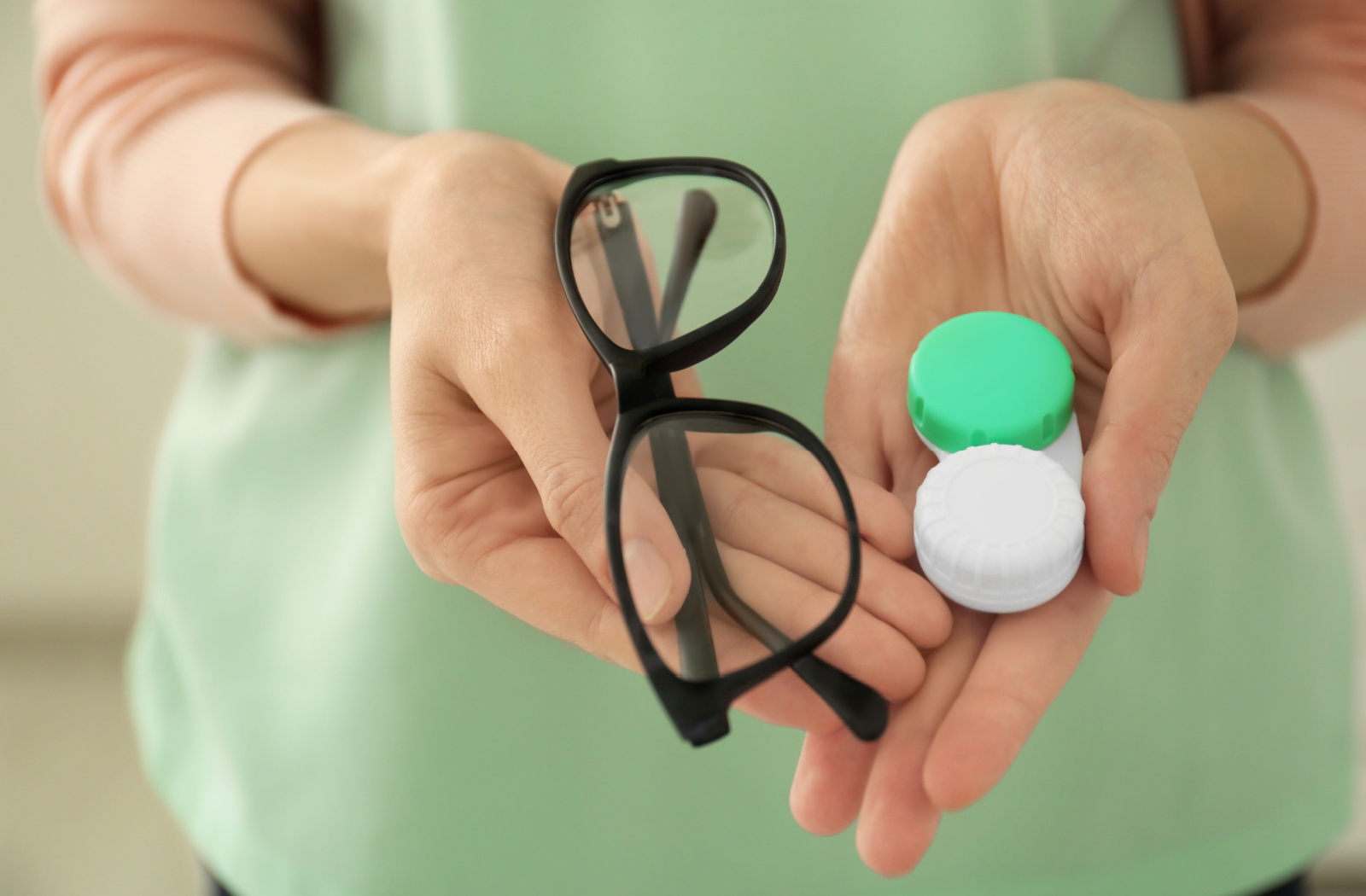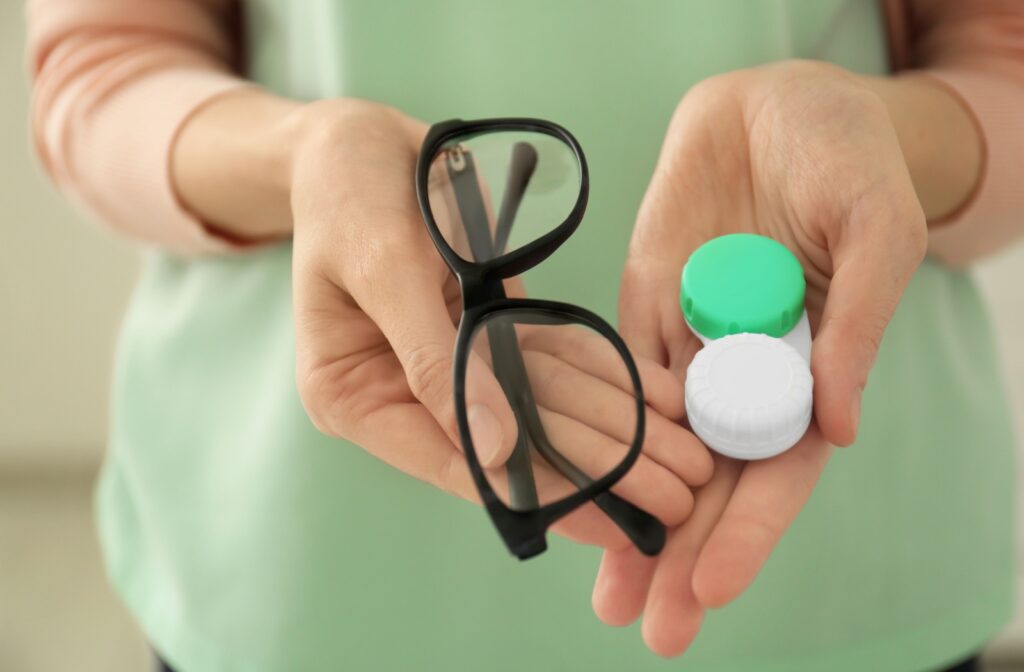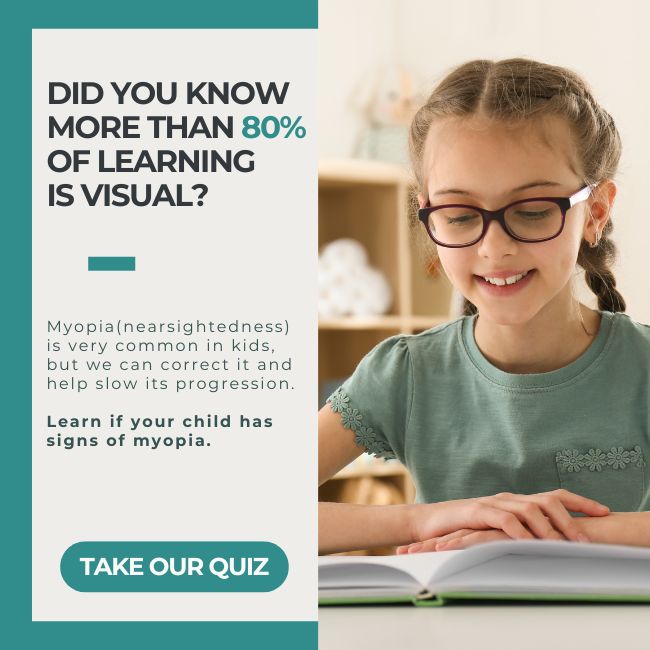If you already have a glasses prescription and want to try contact lenses, you might think you can use the same numbers. However, while they both help you see clearly, prescriptions for glasses and prescriptions for contacts are not the same. This is largely because glasses and contact lenses sit at different distances from your eyes.
If you’re interested in contact lenses, you’ll need to have a fitting.
Why Your Glasses Prescription & Contact Lens Prescription Are Different
Prescriptions for glasses and contact lenses differ largely because of the distance that each device sits from your eye. Glasses rest on your nose, about 12 millimetres away from your eyes. Contact lenses, on the other hand, sit directly on the surface of your cornea. This gap might not seem like much, but it changes how light focuses on your retina. Your eye doctor must calculate this difference, called the back vertex distance, to adjust the lens power of your glasses or contacts. This calculation is a key part of what gives you sharp, accurate vision.
More Than Just Power
A contact lens prescription contains much more information than just the corrective power. These extra details are necessary for a lens that fits well, feels comfortable, and keeps your eyes healthy.
- Base Curve (BC): This number refers to the curvature of the contact lens. To sit securely on your eye without moving too much or being too tight, the base curve of the lens must match the shape of your cornea.
- Diameter (DIA): The diameter is the measurement of the lens from edge to edge. It determines how the lens is centred on your eye and ensures it covers your pupil and iris correctly.
- Lens Brand & Material: Different brands use different materials that affect oxygen flow and moisture to your eye. Your eye doctor will recommend a specific type based on your eye health, lifestyle, and whether you might need dry eye therapy.
How Prescription Power Changes for Contacts
For those with a lower prescription, the power numbers on glasses and contact lens prescriptions might look very similar. However, once a prescription is stronger than +/- 4.00 diopters, the differences increase. An eye doctor must recalculate the power of your contact lenses to compensate for their position on the eye.
You may come across online converters or formulas that claim to change your glasses prescription into one for contacts. These shortcuts are not dependable and can lead to problems with your vision and eye health. Your eyes are unique, and a generic formula cannot account for your specific corneal shape or tear film quality.
Trying to guess your prescription can result in blurry vision, headaches, and eye strain. It can also lead to more serious issues if the fit is incorrect. The only way to get the right prescription is through a professional fitting.

The Value of a Professional Contact Lens Fitting
A contact lens is a medical device that sits directly on the sensitive surface of your eye. An improper fit can affect your eye health, which is why a dedicated contact lens exam is so important.
We see this fitting process as a collaboration where we work with you to find the most suitable option for your vision and lifestyle. It’s about finding a lens that not only helps you see well but also feels good all day long.
What Happens During a Fitting
A contact lens fitting involves a few extra steps beyond a standard eye exam. We take the time to gather all the necessary information for a successful fit. Here is what you can expect:
- We measure the curvature and size of your cornea with special instruments. These measurements guide the selection of the correct base curve and diameter.
- We look at your tear film to see if you might be prone to dry eye, which helps us choose a lens material that will stay moist and comfortable.
- You’ll get to try on a pair of trial lenses, so we can check the fit, see how they move, and confirm that your vision is clear.
Once we find the right lens, we teach you how to insert, remove, and care for them properly to keep your eyes healthy.
Risks Associated with an Improper Fit
Ordering contact lenses online using your glasses prescription might seem convenient, but it can cause a number of issues. A lens that doesn’t fit correctly can deprive your cornea of oxygen and may lead to irritation or even a corneal ulcer. A proper fit from an eye doctor helps you avoid these preventable problems.
Your comfort and health are our priorities. A well-fitted lens should feel like nothing is there while providing clear vision. That is the standard we aim for with every contact lens fitting.
Potential Complications
If you experience any of the following symptoms, it could be a sign that your contact lenses are not a good fit for your eyes. Common signs of an improper fit include:
- A feeling of discomfort, itching, or like there is something in your eye
- Persistent redness and irritation
- Increased eye dryness
- Scratches on the cornea or other issues requiring emergency eye care
Schedule an Exam with an Optometrist In South Surrey & White Rock
The only safe and accurate way to get contact lenses is to receive a valid prescription from an eye care professional. At Insight Eyecare, we can conduct a thorough exam and fitting to find the ideal lenses for your unique eyes. This ensures your vision is clear and your eyes remain healthy.
We can help you navigate the many types of contact lenses available today, from daily disposables to options for astigmatism or presbyopia. You don’t have to figure it out on your own.
Your Next Step for Clear Vision
If you’re thinking about trying contact lenses for the first time, or if you need an updated prescription, a contact lens exam is your next step. This dedicated appointment allows us to give you the attention and care required for a successful fit. You can enjoy the freedom and convenience of contact lenses with confidence. At Insight Eyecare, your vision and eye health are at the centre of everything we do. Our team is ready to provide you with a comprehensive contact lens fitting and answer all your questions. Book your appointment today to get started.







